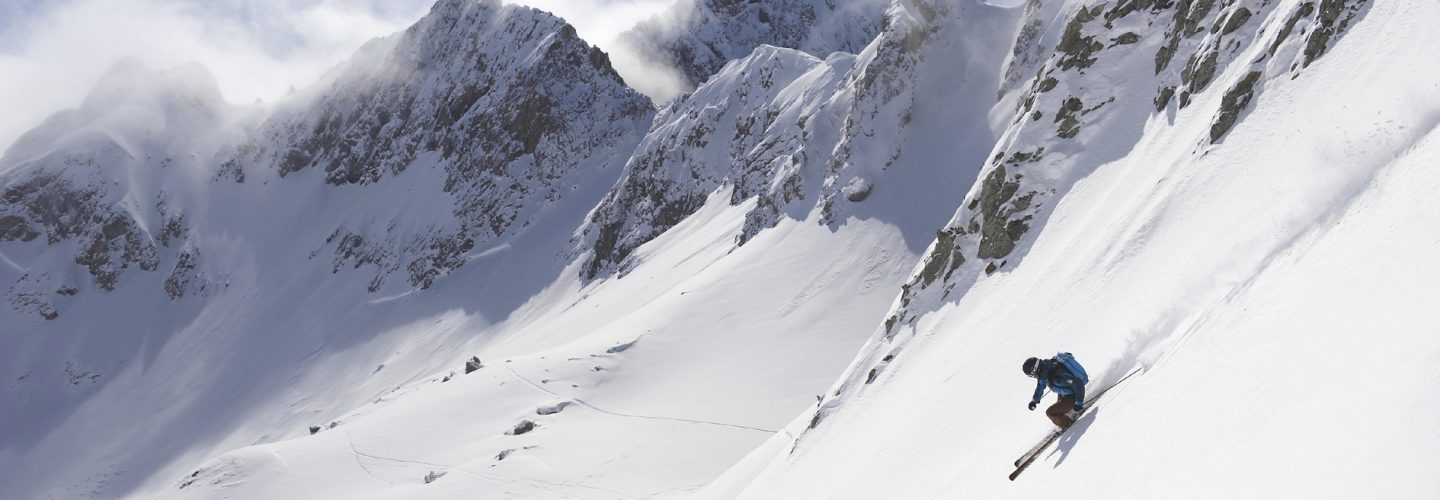Austria’s biggest ski areas offer some of the most expansive terrain in the Alps, drawing skiers from across the globe with their sheer scale and variety. From the legendary slopes of the Arlberg to the broad, family-friendly mountains of Schladming-Dachstein, these regions deliver serious mileage and unforgettable alpine character. Kitzbühel combines heritage and high-end appeal with vast, well-connected pistes, while Zell am See-Kaprun adds glacier access and panoramic lake views to its extensive network. Together, these four giants showcase Austria’s strength in large-scale, high-quality skiing—where modern lift systems, reliable snow, and diverse terrain come together in style.
But beyond the scale of its ski areas, what truly sets an Austrian ski holiday apart is its Lebensgefühl—a deep-rooted “feeling of life” that pulses through every mountain village and après-ski moment. It’s embodied by the people who make your stay unforgettable: the lift operators who greet you with a grin, the chefs who serve up soul-warming dishes, the ski instructors, bartenders, and kids’ club teams who share their joy with every guest. This is Austria at its most personal and profound. So don’t just ski here—connect, laugh, and discover your own Lebensgefühl in the heart of the Alps.
The Arlberg
The Arlberg region is steeped in alpine legend, often hailed as the cradle of skiing and home to Austria’s largest interconnected ski area. Straddling the border between Tirol and Vorarlberg, it comprises five distinctive villages—St. Anton, St. Christoph, Stuben, Lech and Zürs—each with its own character, yet united by a shared passion for snow sports, hospitality and mountain culture. From the aristocratic charm of Lech to the freeride playground of Stuben and the sporty energy of St. Anton, the Arlberg offers a winter experience that’s both refined and exhilarating.

© Tourismusverband-St-Anton-am-Arlberg_photographer_Lucas-Tiefenthaler
Skiing here is world-class in scale and quality. The Ski Arlberg area boasts 300 km of groomed pistes, 200 km of high alpine deep snow terrain and 85 lifts and cable cars. The terrain is varied and vast, with everything from gentle cruisers to steep powder fields. Freeriders will find dream conditions, with wooded sections enhancing safety and offering the best chance of getting first tracks. Signature circuits like the Run of Fame and the White Ring link multiple villages in scenic loops, while the Mohnenfluh runs deliver panoramic descents with dramatic views.
Speaking of views, the Valluga viewing platform offers a breathtaking vantage point over five countries—Austria, Germany, Switzerland, Italy and Liechtenstein. Meanwhile, Rüfikopf provides a 360° panorama of the Lech Zürs mountainscape, with views stretching across the village and surrounding peaks.
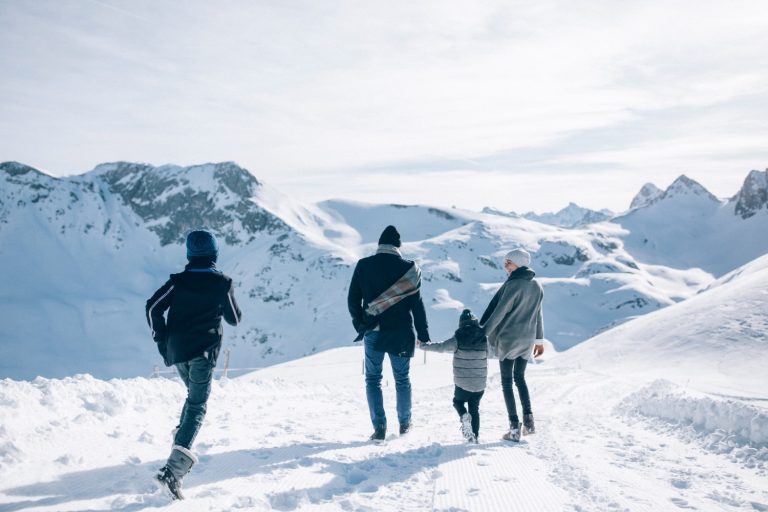
© Lech-Zuers-Tourismus_photographer_Daniel-Zangerl
Off the slopes, Arlberg’s winter offerings are just as rich. Visitors can explore winter hiking trails through the Zugertal valley or try snowshoeing in untouched alpine terrain. Wellness seekers will appreciate Arlberg WellCom, a modern spa and fitness centre in St. Anton, while indoor options like arl.park trampoline park and arl.flow yoga offer fun and relaxation when the weather turns.
Families and adventurers alike can enjoy unique experiences such as husky sledding in St. Anton or cultural highlights like Skyspace-Lech, a James Turrell light installation that blends art and alpine atmosphere. For a truly unusual experience, Oberlech operates as a traffic-free zone in winter, with guests arriving via cable car and goods transported through underground tunnels by electric vehicles—a concept unique in Europe.
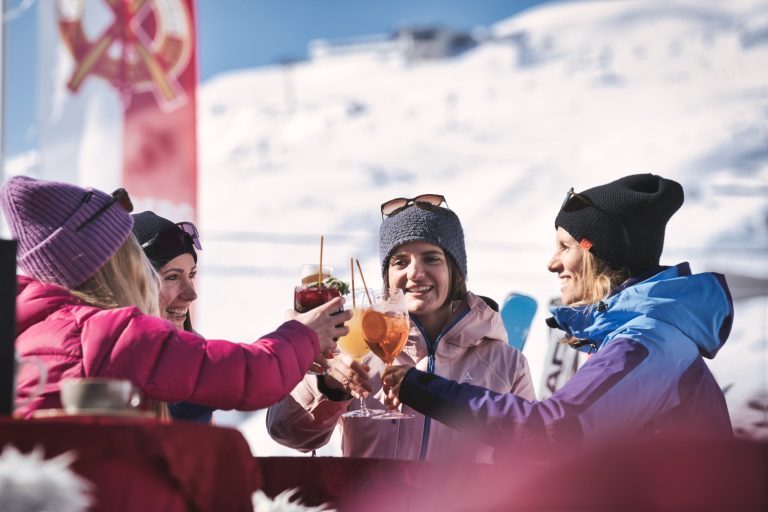
© Tourismusverband-St-Anton-am-Arlberg_photographer_Patrick-Baetz
Dining is a standout feature across the region. With over 30 Gault Millau-awarded restaurants, Arlberg has the highest density of gourmet establishments in Europe. Whether it’s a rustic hut or a five-star hotel, culinary excellence is a given. Highlights include Rud-Alpe, a former hay barn now serving pan-fried and grilled specialties, and Verwallstube, one of the highest toque-awarded restaurants in Europe. For a truly immersive experience, the Rote Wand Chef’s Table offers a multi-course journey through regional ingredients and storytelling.
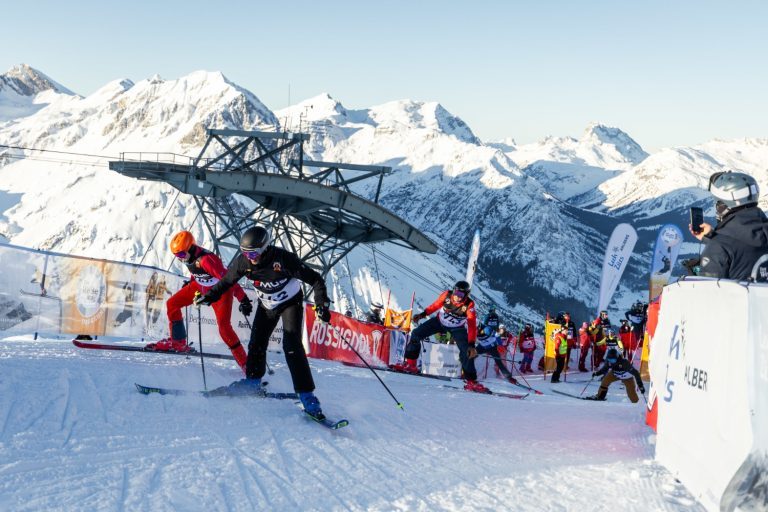
© Lech-Zuers-Tourismus-GmbH_photographer_Simon-Rainer
This winter’s event calendar is, as every winter here, packed with highlights. The season kicks off with the STANTON Ski Open in December, followed by the White Ring – The Race in January. April brings the Tanzcafé Arlberg Music Festival, the Longboard Classic in Stuben, and the thrilling White Thrill race in St. Anton.
Sustainability is a core value across the region. Lech Zürs operates biomass heating plants that supply nearly all households and businesses with renewable energy. The local Blue Fleet bus service encourages car-free travel, and the Green Garage supports electric vehicles. In St. Anton, the Kartell hydroelectric plant makes the village energy self-sufficient, and the municipality is part of Austria’s e5 energy-efficient program, driving forward climate goals with solar heating and local biomass networks.
Getting to Arlberg is easy and can be eco-friendly too if you want it to be. St. Anton am Arlberg is a Railjet hub with seven direct trains daily from Vienna and Zurich, and the local station doubles as a tourist information centre. Once here, regular buses connect all villages, and short distances make walking a viable option throughout. For air travel, Innsbruck, Zurich and Friedrichshafen airports offer convenient access.
Schladming-Dachstein
Set between the mighty Dachstein massif and the Schladminger Tauern, the Schladming-Dachstein region in Styria is known for its diversity and welcoming spirit. Part of Austria’s largest ski alliance, Ski amadé, it delivers a seamless blend of adventure, relaxation, and cultural depth to visitors.
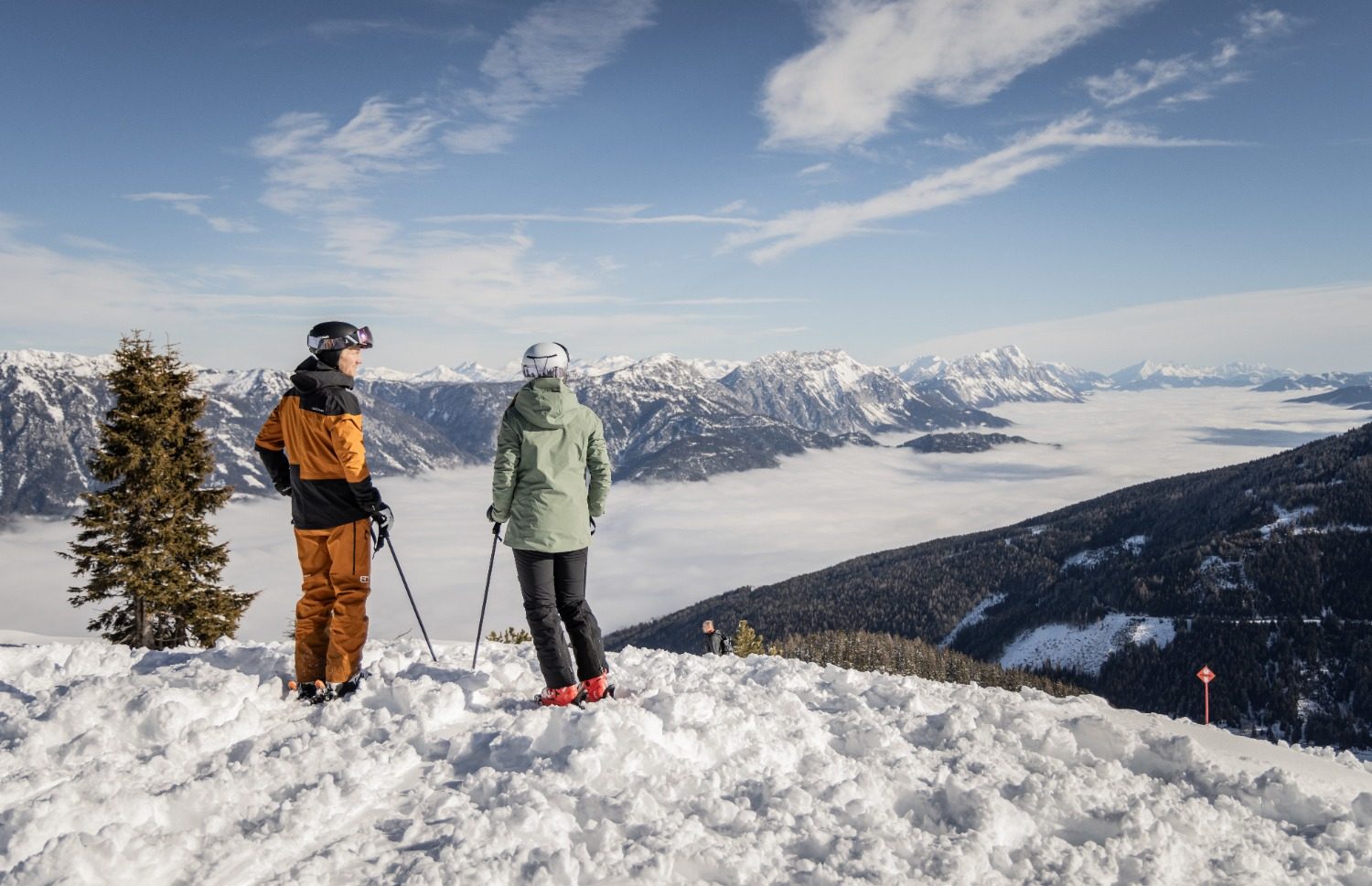
Image © Schladming-Dachstein_photographer_Mirja-Geh
Skiers are spoiled for choice with 230 km of slopes across nine ski mountains, including the renowned Schladming 4-mountain ski area, which links Hauser Kaibling, Planai, Hochwurzen, and Reiteralm. These four peaks offer everything from World Cup-level descents and freestyle parks to family-friendly pistes and night skiing.
The wider region boasts 98 lifts, 220 km of cross-country trails, and 300 km of groomed winter hiking paths. Smaller resorts like Galsterberg, Fageralm, and Planneralm add to the variety, with natural snow slopes and themed children’s areas.
This winter sees new lift upgrades, including a 10-seater gondola on Hauser Kaibling and an 8-seater chairlift on Planai, ensuring faster access and more time on the snow.
The views are spectacular from multiple vantage points. Ride the panoramic cable car to the Dachstein Glacier at 2,700 m and explore the sky ladder, suspension bridge, and stairway to nowhere. From the summit of Hauser Kaibling, the Enns Valley unfolds beneath you, while the Steirerherz on Reiteralm offers a postcard-perfect view of the Dachstein massif.
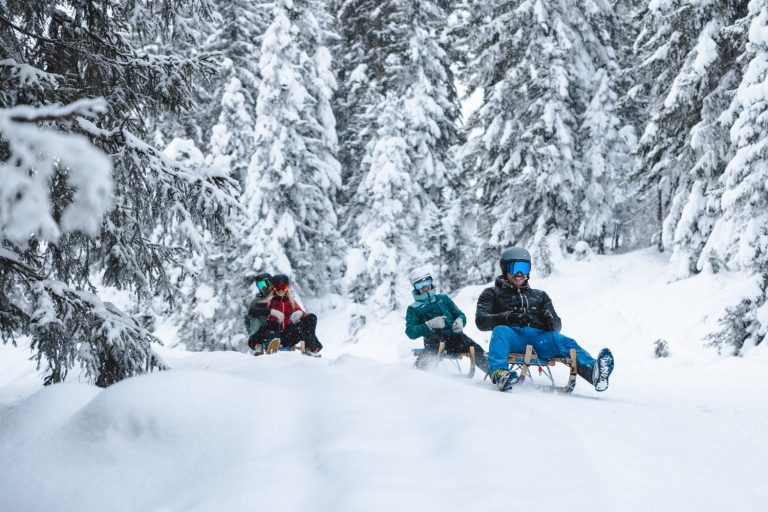
© TVB-Schladming-Dachstein_photographer_Mathaeus-Gartner
Beyond skiing, the region excels in off-piste activities. Try fat biking, ice skating on Putterersee, or snowshoeing through fairy-tale forests. Tobogganing is a highlight, especially the 7.7 km floodlit run on Hochwurzen. Ramsau’s horse-drawn sleigh rides and ski yoga sessions add a touch of romance and mindfulness respectively. If the weather turns, cozy up in a mountain hut or unwind at the Acquapura SPA at Falkensteiner Hotel Schladming.
Winter 2025/26 brings a packed calendar of events. The Ski Opening kicks off with the Backstreet Boys performing live on 5 – 7 December. In January, the legendary Nightrace transforms Planai into a floodlit arena for FIS World Cup night giant slalom and night slalom. Advent markets in Pürgg and Ramsau offer mulled wine, Krampus parades, and nativity scenes, while the Dachstein Run cross-country marathon returns in January with routes for all levels.
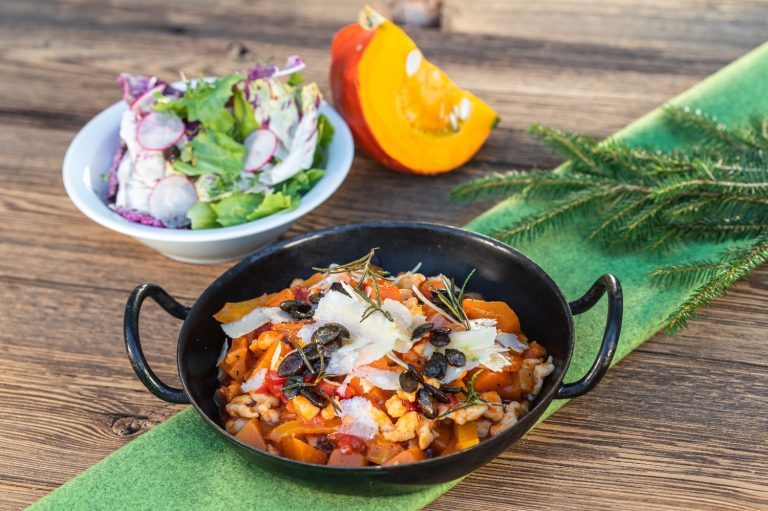
© TVB-Schladming-Dachstein_photographer_Martin-Huber
Dining here is a delight. The “Almkulinarik by Richard Rauch” initiative brings gourmet flair to ski huts, with dishes like blackberry-studded miasl and hearty soups served with Styrian wine and panoramic views. For a twist, combine ribs with night tobogganing on Hochwurzen.
Special offers this season include four-night ski and wellness packages at Hoflehner Hotel, complete with ski passes, massages, and pine needle baths. The Falkensteiner Hotel offers discounted rentals and ski bus access, just five minutes from the Planai lift.
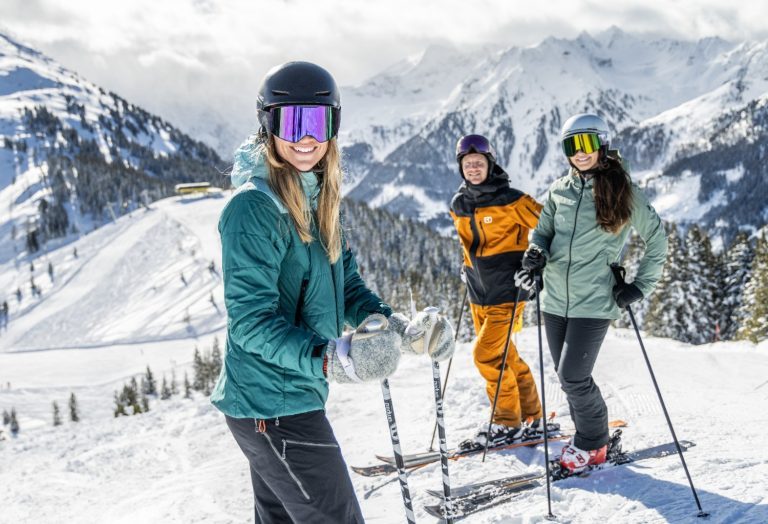
© TVB-Schladming-Dachstein_photographer_Mirja-Geh
For something truly special, try early bird skiing on Hauser Kaibling followed by breakfast at Krummholzhütte, or ski tour up Planai for a peaceful descent and a hut-side reward. The sunny terraces at Reiteralm and Hochwurzen are perfect for unwinding with a drink and soaking up the alpine glow.
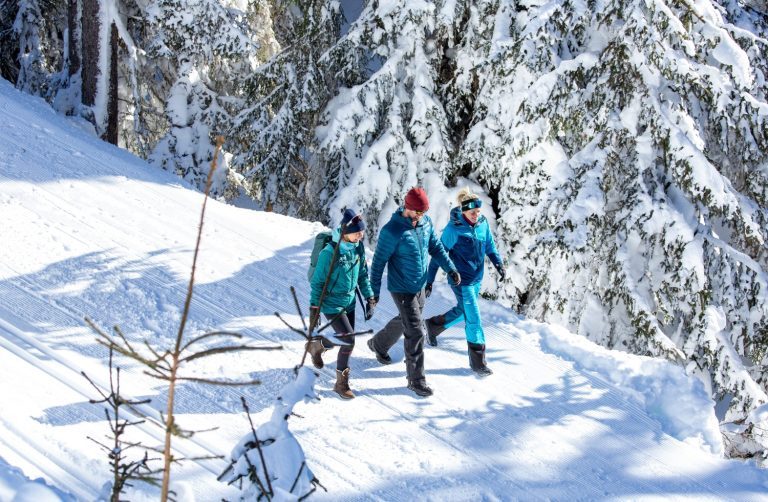
© photo.austria.at_photographer_Hans-Peter-Steiner
Schladming-Dachstein is also taking sustainability seriously. The Planai-Hochwurzen cable cars aim for 16% energy self-sufficiency by 2029, using solar power and biofuel. Riesneralm’s snowmaking runs entirely on hydroelectric energy, and Hauser Kaibling’s summer sheep grazing helps preserve the alpine landscape. Local food initiatives and inclusive employment projects round out the region’s responsible tourism strategy.
Getting here is easy. Rail connections via Salzburg or Graz link to Schladming, with onward bus services to the resorts. For international visitors, Salzburg and Munich airports offer the most direct access.
Kitzbühel
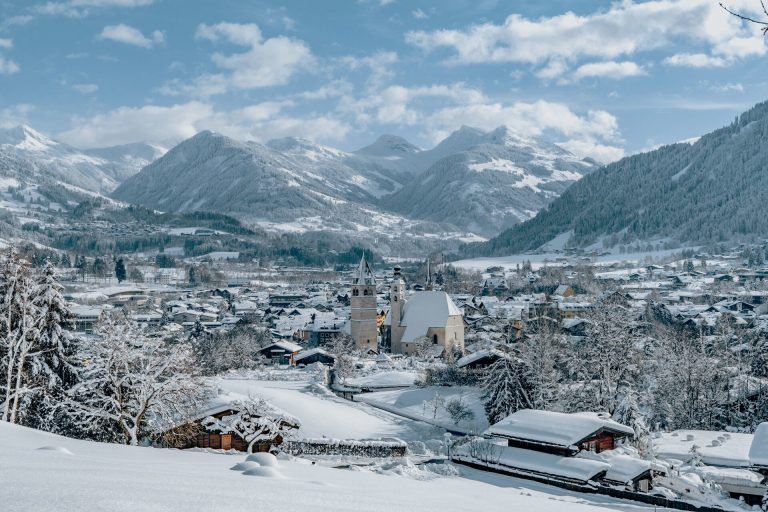
© Kitzbuehel-Tourismus
Kitzbühel, located in the centre of the Austrian Alps, is a ski destination that blends centuries of heritage with modern luxury and plenty of exciting winter adventure. With over 750 years of history and voted Austria’s Best Ski Resort on multiple occasions, it’s a destination that doesn’t just offer skiing—it offers a whole lifestyle. The town’s colourful facades, cobbled streets, and Tyrolean charm set the stage for a winter experience that’s as culturally rich as it is snow-filled. Kitzbühel is also the birthplace of the Ski World Cup and home to the legendary Streif – Hahnenkamm race, a daring downhill course that draws over 80,000 fans each year and is the most prestigious events in the ski racing calendar, a win equating to Winter Olympic gold, or better.
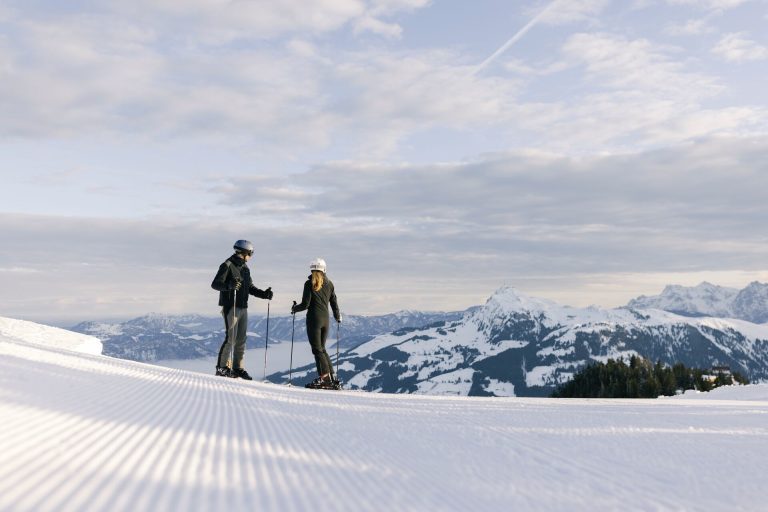
© Kitzbuehel-Tourismus
The skiing here is world-class. With 96 marked pistes covering a total of 233 km, accessed via 58 state-of-the-art lifts and cable cars, the terrain suits everyone from beginners to experts. The KitzSkiWelt Tour is a big attraction—at 88 km, it’s the longest ski circuit in the world, winding through varied alpine landscapes and offering endless exploration.
You can also ski the route of the Hahnenkamm yourself on the run, marked as piste number 21, which stretches over 3.3 kilometres and offers a gradient of up to 85 percent. If that sounds a little too steep, the Streif family run offers a less challenging alternative that skips the most difficult sections.
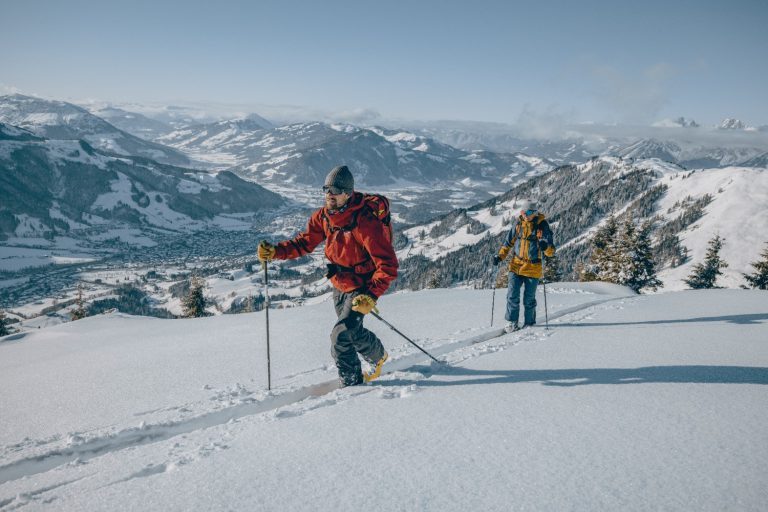
© Kitzbuehel-Tourismus
Away from the downhill slopes cross-country skiers can enjoy 70 km of trails, while snowshoers and winter hikers have access to 34 groomed paths and guided walks. Seven ski schools provide expert instruction, and the Horn Summit Gondola takes visitors to the highest peak at 6,562 feet, offering sweeping views and pristine snow.
Speaking of views, Kitzbühel delivers some of the most photogenic spots in the Alps. The Starthaus on the Hahnenkamm offers panoramic vistas over the town and surrounding villages, while the Kitzbüheler Horn rewards early risers with sparkling solitude and untouched pistes. For a quieter moment, the Black Lake offers a peaceful escape just west of town.
Off the slopes, Kitzbühel is equally engaging. Try snowshoeing on the Hahnenkamm or head to the Sportpark for ice skating and curling at Austria’s only indoor curling hall. If the weather turns, retreat to one of the town’s luxurious spas like the Kitzhof Mountain Design Resort or A-Rosa Kitzbühel, both offering wellness escapes with mountain views. The Hotel Schwarzer Adler adds boutique flair and gourmet dining in an adults-only setting.
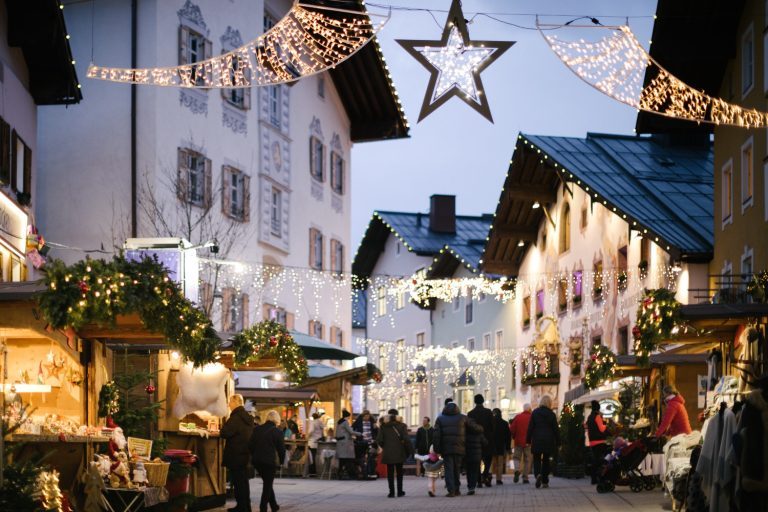
© Kitzbuehel-Tourismus
Winter in Kitzbühel is packed with events and festive charm. The Christmas Market runs from November 19 to December 26, transforming the town into a fairy-tale setting with local crafts, lights, and seasonal treats. Celebrate the New Year with street performances, DJs, and a fire show from December 30 to January 1. 2026 kicks off with the Snow Polo World Cup from January the 15th to 18th, followed by the 86th Hahnenkamm Race from January 19 to 26—an electrifying week of downhill and slalom competition.
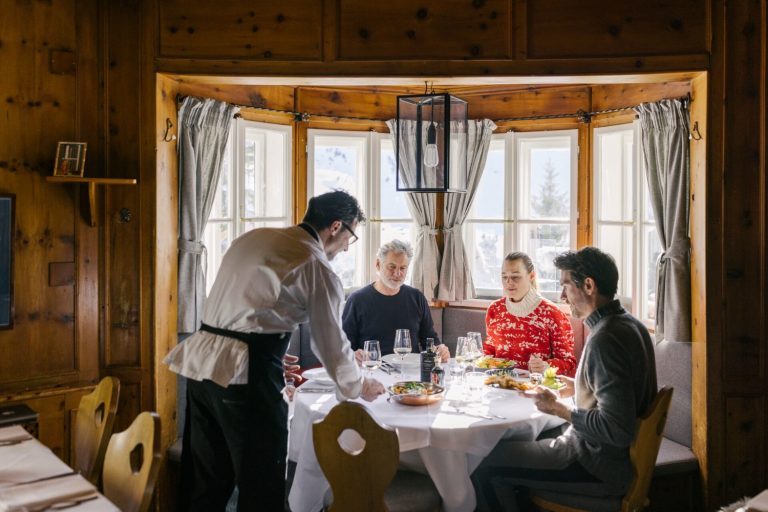
© Kitzbuehel-Tourismus
Dining is a resort highlight with a range that again sets Kitzbühel apart from many destinations. There are over 60 mountain and gourmet restaurants offering everything from rustic Tyrolean fare to refined international cuisine. For a cosy culinary moment, settle in at Panorama Alm for apple strudel on the sun terrace, or indulge in exquisite dishes at Sonnbühel and BichlAlm, a secluded retreat high in the mountains. The resort’s culinary scene is as diverse as its terrain, with something to suit every palate.
Special offers this season include curated stays at top hotels and themed winter programs from local partners. For a playful twist, don’t miss the insider tip: tobogganing on the Gaisberg—a thrilling ride for all ages that rivals the slopes in fun and laughter.
Kitzbühel is also leading the way in sustainability. All cable cars and lifts operate on renewable energy, sourced from regional hydropower and solar, with efficient snow-making supported by GPS and snow depots.
Getting here is simple. Kitzbühel is reachable by train from Innsbruck (1h20), Salzburg (1h15), and Munich (2h). The nearest airports are Salzburg (50 miles), Innsbruck (59 miles), and Munich (99 miles). Once in town, almost everything is walkable, and ski buses are free with your lift pass.
Zell am See-Kaprun
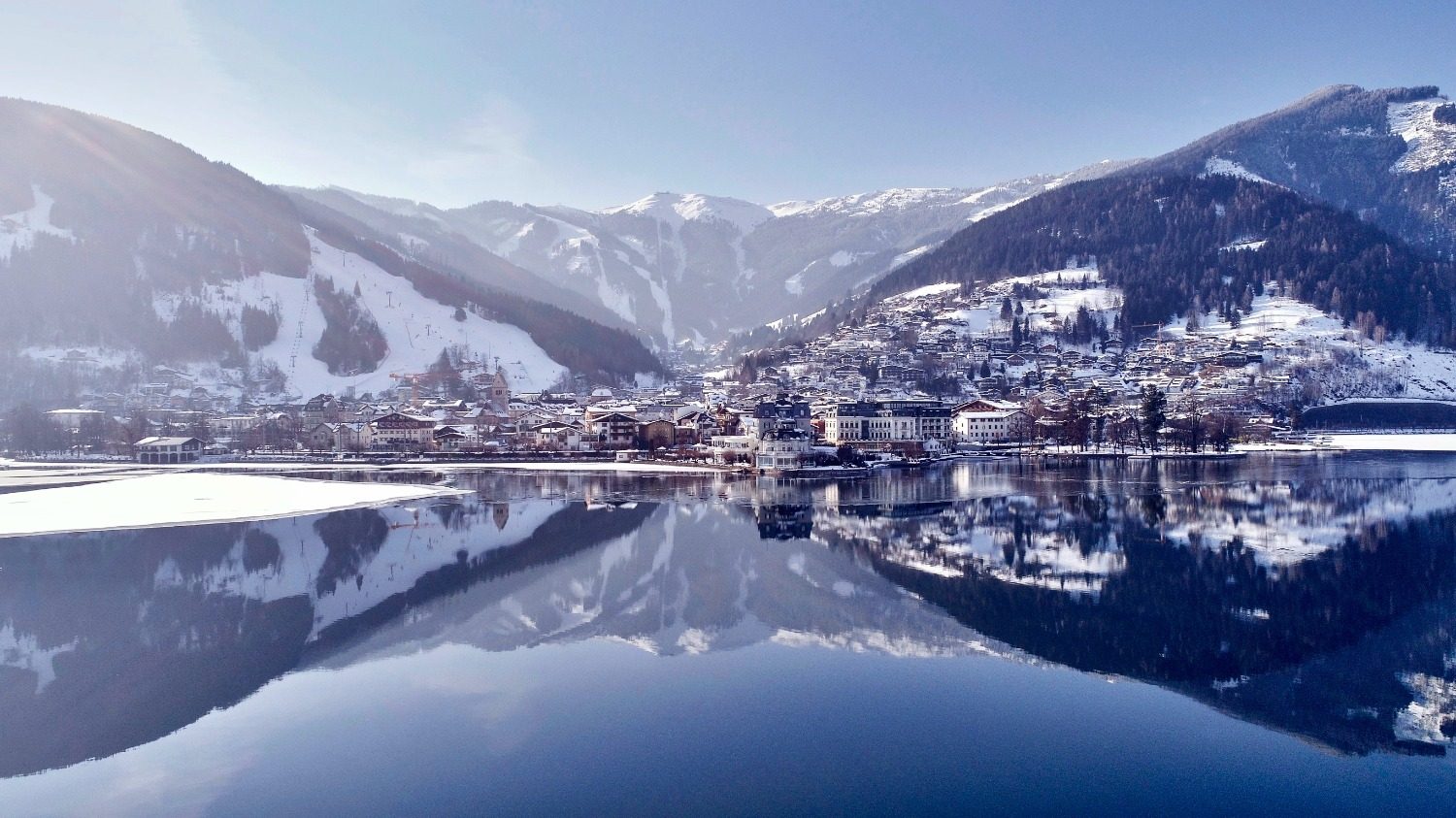
Image © Zell-am-See-Kaprun-Tourismus
Zell am See-Kaprun is a rare alpine gem where glacier, mountain, and lake converge to create one of Austria’s most diverse and exhilarating winter destinations. From the snow-sure heights of the Kitzsteinhorn glacier to the panoramic Schmittenhöhe with its ski slopes for all abilities lying above the shimmering Lake Zell, this region offers a seamless blend of high-altitude adventure and lakeside serenity.
Thanks to the Kitzsteinhorn’s glacier the season stretches from October to late spring, with 408 km of slopes accessible via the Ski ALPIN CARD, which not only includes Schmittenhöhe and Kitzsteinhorn but also the lifts and slopes of the neighbouring Skicircus Saalbach Hinterglemm Leogang Fieberbrunn. In even better news this now joins the incredible global Epic Pass network for winter 2025/26.
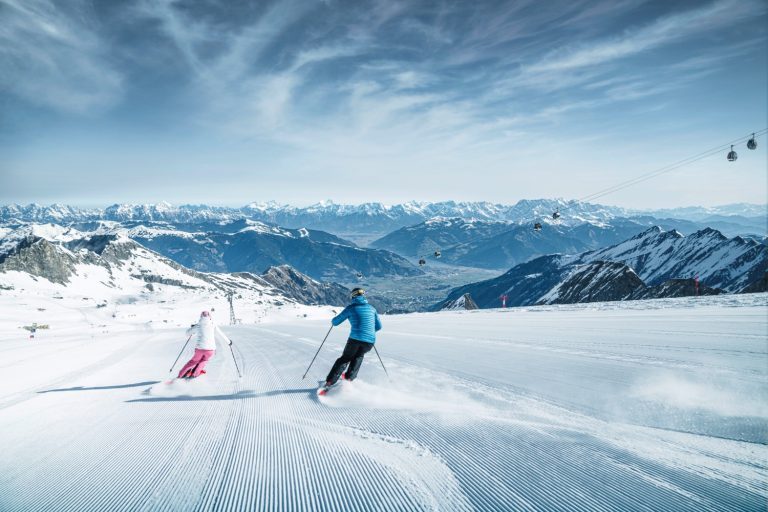
© Gletscherbahnen-Kaprun-AG
Skiers and snowboarders can explore three distinct areas. The Kitzsteinhorn glacier rises to 3,029 m and offers 61 km of slopes and five freeride routes. The Maiskogel, connected via the 3K K-onnection, is ideal for families and beginners, with gentle terrain and the playful Maisi Park. Meanwhile, the Schmittenhöhe delivers 77 km of pistes, five long valley runs, and the thrilling “Trass” descent with a 70% gradient. Freestylers flock to the Funslope XXL and snow parks, while early risers can enjoy untouched pistes during the weekly Ski’n’Brunch in January and February.
Viewpoints are a highlight here. The TOP OF SALZBURG platform atop the Kitzsteinhorn offers sweeping views of the surrounding National Park Hohe Tauern, while the Kaiserblick on the Schmittenhöhe features a glass-floored walkway and telescopes to spot 30 three-thousand-metre-high peaks of Hohe Tauern, gliding across Lake Zell. For a quieter perspective, the Ronachkopf above Thumersbach offers panoramic views and alpine hospitality at the Enzianhütte and Mitterberghof.
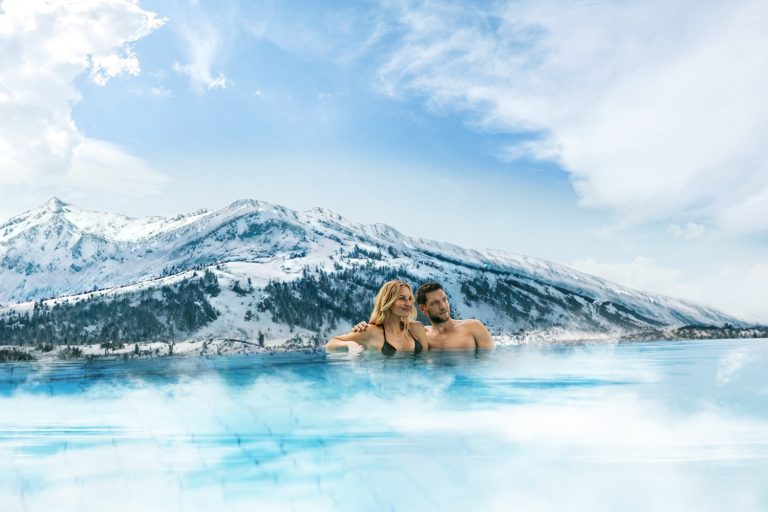
© TAUERN-SPA-Zell-am-See-Kaprun
Beyond skiing, Zell am See-Kaprun offers 107 km of cross-country trails, 42 km of winter hiking paths, and dedicated ski touring routes like the Ronachkopf and the “Ice Queen” and “Icebreaker” ascents on the Kitzsteinhorn. Weekly guided tours to the Tristkogel summit offer breathtaking descents. Non-skiers can enjoy snowshoe hikes, torchlight walks, and wellness escapes at the Tauern SPA, or take part in lakeside yoga and festive boat rides on Lake Zell during advent.
The resort’s winter calendar is packed with events. The Starry Advent transforms the lakeside promenade and the charming village of Kaprun with lights, music, and markets. Night skiing on the Schmittenhöhe runs every Tuesday and Thursday, while the Kitzsteinhorn Explorer Tour offers a guided journey through four climate zones to the glacier summit. Families can enjoy the redesigned Kids Indoor Park Areit 1400, packed with slides, bouncy castles, and games.
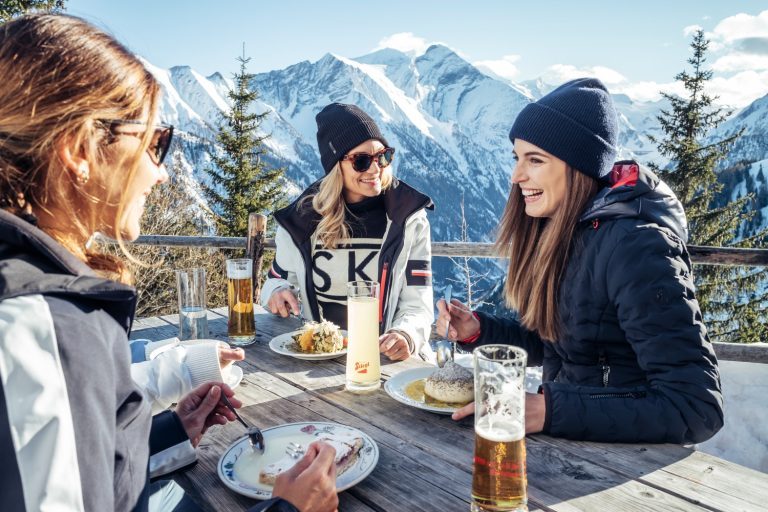
© Zell-am-See-Kaprun-Tourismus
Dining here is a celebration of Alpine cuisine. The Gipfel Restaurant at 3,029 m serves regional delicacies with panoramic views, while the newly renovated Gletschermühle offers Austrian classics at 2,450 m. On the Schmittenhöhe, the Franzl serves imperial-royal specialties, and the AreitLounge combines modern flair with open fires and mountain views. The region boasts 90 restaurants, including eight Gault Millau toque-awarded establishments, many of which are part of the “Via Culinaria” culinary trail.
Special offers include the Ski’n’Brunch experience, summit breakfasts at the Gipfel Restaurant, and the Epic Pass partnership for international guests. The Ski ALPIN CARD unlocks 408 km of slopes in the three skiing areas with free ski buses.
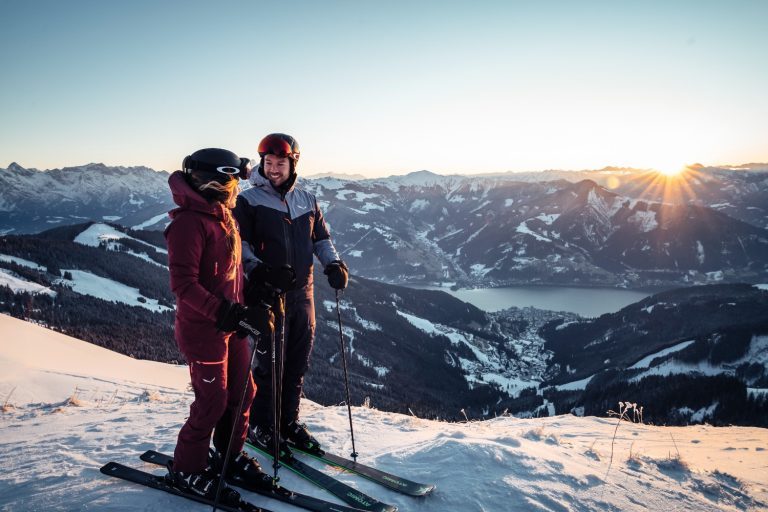
© Zell-am-See-Kaprun-Tourismus
Sustainability is woven into the region’s DNA. Zell am See-Kaprun is in the final phase of certification for the Austrian Ecolabel for Destinations. The Schmittenhöhebahn AG is Europe’s only EMAS-certified cable car and operates electric snow groomers powered by 100% renewable energy. Ecological slope management supports biodiversity, and snowmaking uses meltwater from Lake Zell and local streams. The Gletscherbahnen Kaprun AG uses HVO plant-based fuel, solar power, and heat recovery systems, and has implemented a high-altitude reclamation project to protect the glacier environment.
Getting here is easy and eco-friendly. The Zell am See train station sits in the town centre, with direct connections from European cities. Guests can walk to hotels or take free ski buses and shuttles. The ÖBB transfer service covers the last mile sustainably, and the Pinzgauer Lokalbahn offers car-free access to the slopes. And the Guest Mobility Ticket allows overnight guests to travel on all public transport throughout SalzburgerLand.
Find out more at austria.info
Main Image © Lech-Zuers-Tourismus-GmbH


